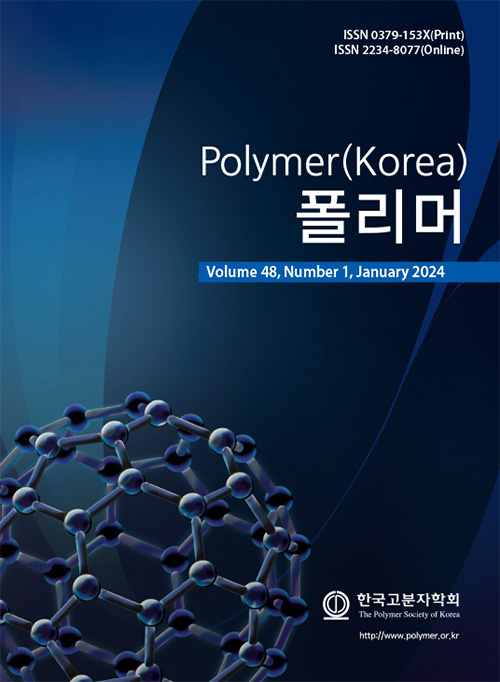- The Fabrication of Acrylic Acid and Boron Nitride Coated Nanotopographical Substrate for New Bone Formation
Min Suk Lee*, Young Min Shin*, Jin Jeon*, and Hee Seok Yang*, **,†

*Department of Nanobiomedical Science, Dankook University, Cheonan 31116, Korea
**Bio-Medical Engineering Research Center, Dankook University, Cheonan 31116, Korea- 골 재생을 위한 Acrylic Acid와 Boron Nitirde가 코팅된 나노지형학 지지체 제조
*단국대학교 나노바이오의과학과, **단국대학교 바이오의료공학 핵심연구지원센터
Reproduction, stored in a retrieval system, or transmitted in any form of any part of this publication is permitted only by written permission from the Polymer Society of Korea.
In recent years, there has been increasing interest in the development of biomimetic scaffolds that mimic the native environment and structure of specific tissues for tissue engineering applications. In this study, we fabricated a scaffold mimicking the longitudinally aligned collagen bundles constituting bone tissue using poly(lactic-co-glycolic acid) nanopatterned substrate that was prepared via solvent-assisted drop casting and capillary force lithography. Furthermore, to enhance interactions between biological interfaces and our substrate, we modified surface of nanopatterned substrate that was grafted acrylic acid using gamma-irradiation. Also, we coated electrically conductive material, boron nitride through Van der Waals force with grafted acrylic acid (referred to P-BN-Np). We confirmed through SEM that surface of P-BN-NP was not damaged during surface modification process. P-BN-Np showed much higher mineral depositions compared to other group in in vitro osteogenic differentiation tests. For proving regenerative capacity of P-BN-Np about bone regeneration, we performed mouse calvarial defect model. After 8 weeks, P-BN-Np presented significantly higher new bone formation area, volume and density compared to other group through micro-CT, histological and immunohistological analyses. Therefore, P-BN-Np, developed in this study, holds promise as a biomimetic scaffold for tissue engineering, offering a versatile platform for regenerating various tissues.
최근 조직공학용 생체재료 개발 측면에서 특정 조직의 생체 내 환경 및 형태를 모사하는 생체모사형 지지체 개발에 관심이 높아지고 있다. 이에 본 연구진은 골 조직을 구성하고 있는 길이 방향의 콜라겐 다발을 생분해성 및 생체적합성 고분자인 poly(lactic-co-glycolic acid)로 solvent-assisted drop casting과 capillary force lithography를 이용하여 나노스케일의 그루브-릿지 형태의 패턴으로 모사한 지지체를 제조하였다. 또한 이식 시, 생물학적 계면과의 상호작용을 향상시키기 위해 지지체의 표면을 감마선 조사를 이용해 acrylic acid를 그라프팅 하였고 전기전도성 물질인 boron nitride를 그 위에 코팅하여 지지체의 표면개질을 완료하였다(P-BN-Np). 주사 전자 현미경을 통해 식각된 나노패턴이 표면개질 과정에서 영향을 받지 않는다는 것을 확인하였으며, P-BN-Np 위에서 조골세포 골 분화 유도 실험을 진행했을 때, 패턴이 식각되지 않은 그룹(P-BN-Flat) 보다 더 높은 칼슘 침착량을 보이는 것을 확인하였다. P-BN-Np의 골 재생효과를 검증하기 위해 마우스 두개골 결손 모델에 이식 8주 후 방사선학적 분석을 통해 결과를 확인했을 때, 골 결손 부위의 상단 부분이 재생되어 나노패턴과 표면개질 인자들의 시너지 효과를 확인할 수 있었다. 따라서 이상에서 개발된 P-BN-Np는 조직공학용 생체모사 지지체로서 다양한 조직을 재생시키기 위한 응용 플랫폼으로 활용될 수 있을 것으로 기대된다.
Keywords: boron nitride, nanotopography, poly(lactic-co-glycolic acid), electrical conductivity, mouse calvarial defect model, bone regeneration.
- Polymer(Korea) 폴리머
- Frequency : Bimonthly(odd)
ISSN 0379-153X(Print)
ISSN 2234-8077(Online)
Abbr. Polym. Korea - 2022 Impact Factor : 0.4
- Indexed in SCIE
 This Article
This Article
-
2024; 48(1): 86-92
Published online Jan 25, 2024
- 10.7317/pk.2024.48.1.86
- Received on Oct 6, 2023
- Revised on Dec 7, 2023
- Accepted on Dec 13, 2023
 Correspondence to
Correspondence to
- Hee Seok Yang
-
*Department of Nanobiomedical Science, Dankook University, Cheonan 31116, Korea
**Bio-Medical Engineering Research Center, Dankook University, Cheonan 31116, Korea - E-mail: hsyang@dankook.ac.kr









 Copyright(c) The Polymer Society of Korea. All right reserved.
Copyright(c) The Polymer Society of Korea. All right reserved.